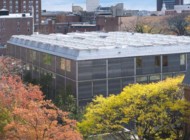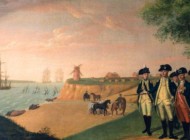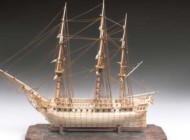._armchair_(one_of_a_pair)_ca._1700._-783x1024.jpg)
Armchair, one of a pair attributed to Thomas Roberts (active 1685-1714), circa 1700. Ebonized beechwood, original Genoese velvet covers; 48 by 28 by 32 inches. Purchase, Gift of Irwin Untermyer, by exchange, and bequests of Bernard M. Baruch, Ruth Mabee Lachman Greenleaf, and Irwin Untermyer, by exchange, 1998.
By Laura Beach
NEW YORK CITY – Forget Mad Men. If you really want a lesson in visual style, binge watch The Avengers, the 1960s British television series that brought us sleuth Emma Peel and her partner Mr Steed. At its best during the reign of the insouciant Diana Rigg, The Avengers is a master class in something the British do as no one else can: take Anglophile tradition – they invented it, after all – and with razor-sharp wit and ironic self-awareness turn it on its head.
The skill with which British artists and craftsmen have translated a world of cultural influences into a visual style both soigné and seductive is at the heart of the tale told by the Metropolitan Museum of Art’s new British Galleries, which opened with much fanfare on March 2 and closed 11 days later due to the pandemic. Fresh, exciting, dramatic and playful, the 11,000-square-foot installation asserts the power of British design across four centuries and through nearly 700 works of art, about one-fourth of which were acquired since 2014.
Closed since 2016 and last revised in 1995 in the afterglow of “The Treasure Houses of Britain,” the National Gallery of Art exhibition that turned aristocratic British interiors into an American obsession, the Met’s British Galleries, once swathed in paneling and yards of green damask, had grown dated in appearance and message.
“The galleries were beautiful but rather undervisited. If people found them, they didn’t stay very long. The space lacked drama and luster. Most objects were arranged symmetrically, which led one curator to dub them Noah’s Ark, because everything came in pairs,” says Wolf Burchard, associate curator in the Met’s department of European sculpture and decorative arts, and the point person in charge of the reinstallation.
Lovers of period rooms may be alarmed to discover just how far the recreations have fallen from institutional favor. Still, it is hard to argue with the Met’s decision to treat objects as works of art, not props in eerily empty stage sets. Historical vignettes are used sparingly in the new British Galleries, which instead invite visitors to inspect objects up close and engage with them in unexpected ways. In a tour de force of imaginative design and as an illustration of Britain’s mercantile might, two 10-foot-tall glass towers house roughly 100 teapots. The vessels, many of them produced by the Staffordshire potteries, are the alluring centerpiece of an installation on the theme of “Tea, Trade and Empire.” Similarly, every antiquarian will succumb to what Burchard calls the “Retail Case,” a dazzling glass cabinet housing shoe buckles, snuffboxes, wine glasses, inkstands and other Eighteenth Century delights made to entice Britain’s growing middle class.
To realize the new British Galleries – a “commotion of creativity” as described by Sarah E. Lawrence, head of the Met’s department of European sculpture and decorative arts – the museum collaborated with Robin Standefer and Stephen Alesch, principals in the New York-based design firm Roman and Williams and winners of the 2018 Sir John Soane’s Museum Visionaries Award, bestowed by the London house museum charged with preserving the legacy of Soane, an Eighteenth Century English architect. Like a latter-day Terence Conran, albeit at a higher price point, Roman and Williams also operates the retail home-furnishings store RW Guild at 53 Howard Street in Manhattan’s Soho, should readers care to have a look.
The designers’ brief was to realize in physical form narratives articulated by the curatorial team. Commerce and industry, trade and empire are central to the complex story, which scholars evaluate both for the brilliance of the emerging British luxury-goods market as well as for its squalid dependence on the exploitation of enslaved people and subjugated lands.
“We wanted to move away from the country-house narrative that was really predominant in the previous iteration of the galleries and focus on creativity and entrepreneurship,” says Burchard, adding, “It is the coming and going of artists and craftsmen from abroad motivated by economic incentive or by religious and political persecution that has shaped British art as we know it. Indeed, almost every object on display bears witness to the permeability of Britain’s borders and those of its former empire, featuring multiple narratives that sit side by side.”
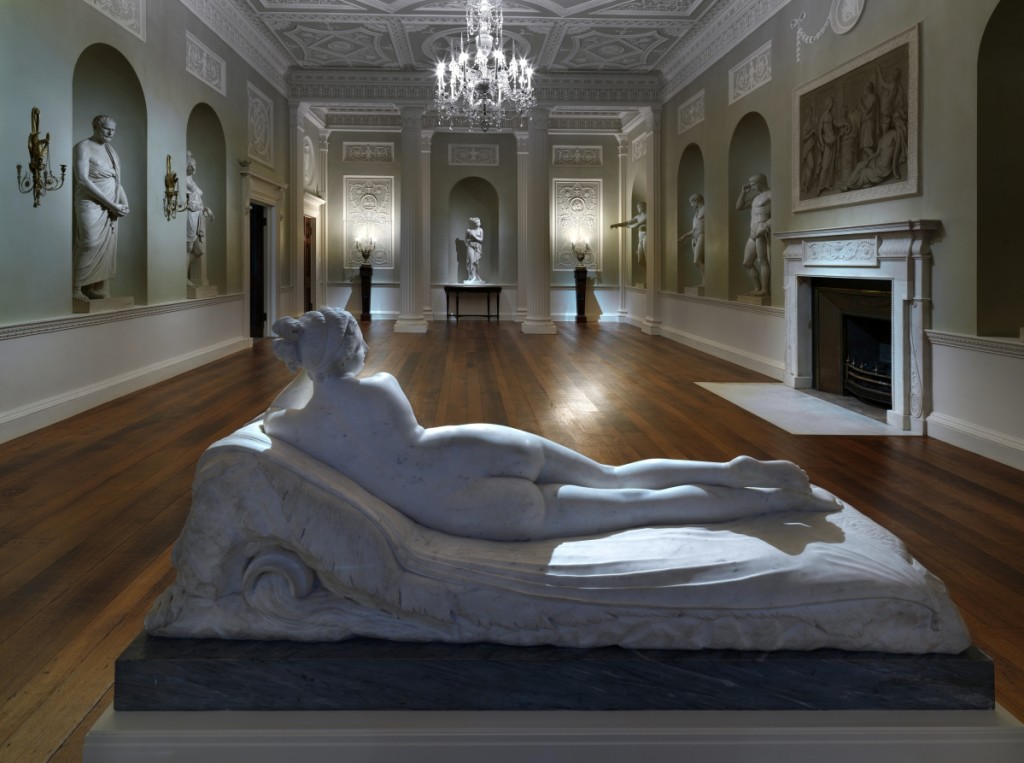
The most striking of three Eighteenth Century English interiors is the Lansdowne Dining Room, constructed between 1766 and 1769 after a design by Robert Adam (1728-1792). In the foreground is Antonio Canova’s (1757-1822) Carrara marble statue “Reclining Naiad,” executed 1819-24. In the niche at the far end of the room is a circa 1822-23 marble statue of Venus attributed to the workshop of Canova, circa 1822-23. The Classical figures on either side are plaster casts. —Joseph Coscia photo
While the overall footprint of the British Galleries has barely changed, the layout has. Visitors now access exhibits through a new entrance off the Medieval Sculpture Hall. Starting in the Sixteenth Century in a small, dark enclosure accented with oak paneling from a house on the Hall Quay in Great Yarmouth, Norfolk, and under the watchful eyes of a circa 1510-15 painted terracotta bust thought to depict Bishop John Fisher – later, as Cardinal, executed by order of Henry VIII – visitors proceed to the Seventeenth Century gallery.
Exemplary textiles illustrate Britain’s growing wealth and global reach. A case in the newly added mezzanine overlooking the Seventeenth Century gallery houses a circa 1600-20 spread, probably for a cradle, made of crimson satin embroidered with silver and gilded silver metal-wrapped thread. “It’s a most extraordinary acquisition made specifically for the new galleries and an example of English objects at their very best. It clearly has not seen the light of day since it was first made,” Burchard says.
Visitors next pass through the partial recreation of a state bedroom from Hampton Court Palace, circa 1698. They move through an adjacent gallery housing the previously mentioned tribute to the tea trade, at last emerging in the blockbuster Eighteenth Century gallery, where Enlightenment wonders abound. Highlights there include a circa 1735 secretary cabinet enveloped in red, gold and silver japanning. Alongside it, a muscular looking marble top table dating to about 1740-45 is attributed to Matthias Lock after a design by Henry Flitcroft.
The tour ends in the Nineteenth Century gallery, which cleaves between the early decades, dominated by Classicism, and the late decades, awash with Asian influences. “The Met made many, many new acquisitions to tell the story here,” says Burchard, singling out a gilded mahogany bench designed by Thomas Hope before 1807; a marquetry inlaid medals cabinet by George Bullock, circa 1814-18; and a dining room chair designed by Augustus Pugin for the Speaker’s House, Palace of Westminster, manufactured by Holland & Sons in 1859. Holland & Sons also made the so-called Pericles sideboard designed by Bruce J. Talbert. Its Gothic ornament and looming proportions are not to everyone’s taste, says Burchard, noting nonetheless, “Objects such as this one reflect the generosity of our supporters, who helped us acquire this piece because they understood it was an important part of the story.”
-1024x747.jpg)
“The Death of Munrow,” Staffordshire, circa 1820-30. Lead-glazed earthenware with enamel decoration, 11 by 14-3/8 by 5¾ inches. Purchase, funds from various donors, the Charles E. Sampson Memorial Fund, and the Malcom Hewitt Wiener Foundation Gift, in memory of George Munroe, 2016.
The final gallery is also the place to admire newly acquired pottery by Doulton and Martin Brothers; porcelain by Minton, Worcester, Moore Brothers and Crown Derby; glass from the Whitefriars Glassworks; and all manner of objects designed by William De Morgan and Christopher Dresser.
The reimagined suite of ten galleries includes three Eighteenth Century interiors, the most breathtaking of which is the Lansdowne Dining Room, designed by Robert Adam and constructed between 1766 and 1769. Faithful to the Scottish architect’s original vision of a sculpture gallery cum dining space “fitted up with elegance and splendor,” as Adam put it, the Met eliminated clutter with the aim of training all eyes on the grandeur of the enclosure anchored at either end by two early Nineteenth Century marble nudes, one, the documented work of Antonio Canova. Through a Palladian window at the gallery’s far end, visitors glimpse scenic vistas rendered by James Boyd in the manner of Eighteenth Century landscape artist Richard Wilson.
The team’s wish that, within practical limits, visitors experience period rooms as they would have been inhabited, not from behind stanchions, contributed to its decision to allow guests to climb a circa 1680 staircase, naturalistically carved in pine and elm after a design by Edward Pearce and salvaged in the 1920s from Cassiobury House in Hertfordshire. After extensive conservation by Met conservator Mechthild Baumeister and her colleagues, who worked from archival photographs and used 3-D laser scans to replicate original elements, the staircase has been reinstalled to dramatic effect and with greater attention to its original appearance and configuration.
The vein of dry British humor mined by The Avengers reaches back to a circa 1674 tapestry from the “Don Quixote in Grotesques” series. Ordered by Charles II’s consort, Queen Catherine of Braganza, and made in London, it is the centerpiece of the Seventeenth Century gallery, as well as a fitting reminder that the new British Galleries, far from keeping calm and carrying on, uphold a boisterous national tradition. As Burchard reminds, “Far too often we forget the decorative arts, in addition to being practical or beautiful, are also supposed to be fun, quirky and a little eccentric.”
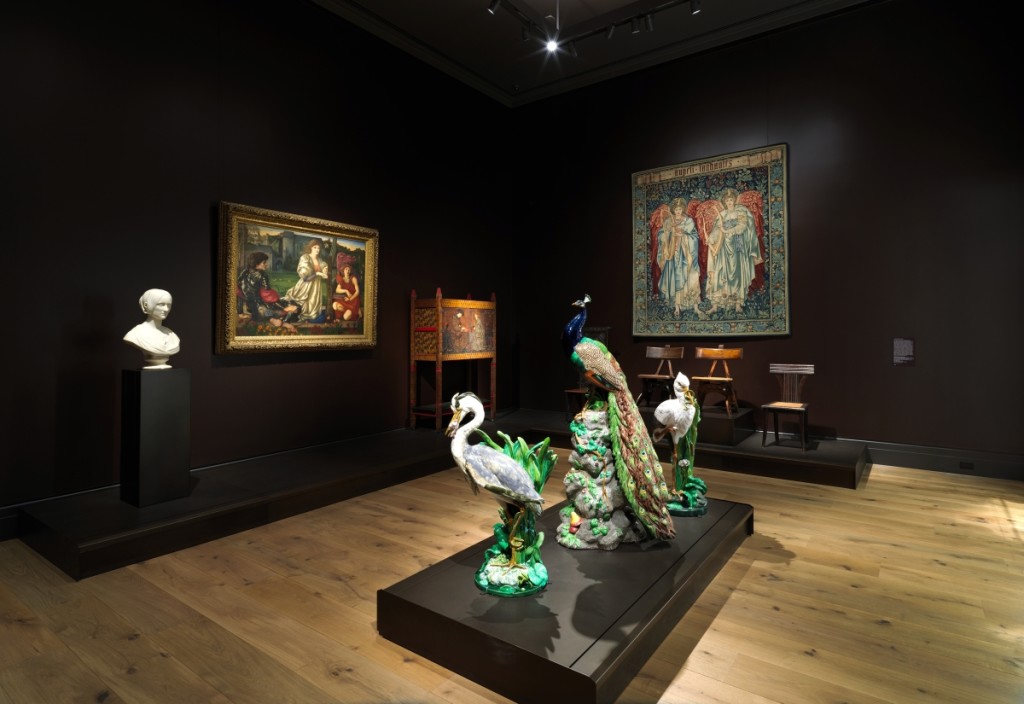
Another view of the Nineteenth Century gallery. Against the left wall is a marble bust of Mary Shelley by Camillo Pistrucci (1811-1854); Sir Edward Burne-Jones’s painting “The Love Song,” 1868-77; and an 1861 cabinet designed by Philip Webb (1831-1915), manufactured by Morris, Marshall, Faulkner & Co., and decorated by Burne-Jones with backgammon players. The Minton majolica figures in the foreground are on loan from Linda Horn. Right are chairs designed by Edward Welby Pugin (1834-1875) and a tapestry manufactured by Morris & Company Weaving workshop at Merton Abbey Tapestry Works in 1898. —Joseph Coscia photo
The new British Galleries are a cornerstone of the Metropolitan Museum of Art’s 150th anniversary celebrations. Other highlights include the exhibition “Making the Met, 1870-2020,” on view through January 3 and accompanied by a catalog of the same name. For details, visit www.metmuseum.org/150.
The Metropolitan Museum of Art will reopen to the public at 25 percent capacity on August 29. All visitors are required to have a timed-entrance registration and are encouraged to visit the website to learn more. For information, 212-535-7710 or www.metmuseum.org.
Unless otherwise noted, all objects are from the collection of the Metropolitan Museum of Art. Photos courtesy the Metropolitan Museum of Art.


.jpg)




._sugar_box_1744-45..jpg)
.jpg)


_ca._1760s..jpg)

.jpg)
._armchair_(one_of_a_pair)_ca._1700._.jpg)


